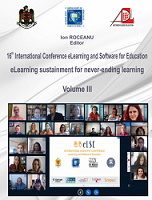TEACHING AND E-LEARNING ABOUT OPEN-END SPINNING MACHINE
TEACHING AND E-LEARNING ABOUT OPEN-END SPINNING MACHINE
Author(s): Ionel Barbu, Andrei Komjaty, Magdalena Simona Fogorasi, Lavinia Culda, Adina Bucevschi, Robert KaminszkySubject(s): Higher Education , ICT Information and Communications Technologies, Distance learning / e-learning
Published by: Carol I National Defence University Publishing House
Keywords: e-learning; cotton spinning; open-end machine; AutoCAD;
Summary/Abstract: This article presents a modern, e-learning method designed for the study of the open-end spinning machine with rotor for processing cotton fibers, blends of cotton and chemical fibers or chemical fibers cotton types. It exposes a new teaching and learning approach of the laboratory for subject Processes and Machines in Cotton Spinning Mill comprised in the academic curricula of the 3rd year students, specialization Technology and Design Textile Products. The open-end spinning machine with rotor is placed at the end of the technological flowchart for manufacturing of unconventional yarns. Within this machine, the band resulted after passing two or three drafting passages, is transformed aiming to improve the quality of the yarn. The main operations carried out in the spinning process comprise: feeding the bands, advanced opener with a opener cylinder until fiber individualization, drafting by means of air flow, twisting of the fibrous reinforcement and winding of yarn and finally wrapping the thread on the bobbin. The work is accomplished in Power Point aiming to capture the attention of the students. Besides, the transition from chapter to chapter or to additional relevant aspects within a chapter is carried out by means of hyperlinks. The kinematic and technological schemes developed on Autocad serve to calculus, kinematic and technological, and facilitate a better understanding of the functioning of the machine, part of the machine or different mechanisms. Supplementary, several images, audio and video files support the learning and understanding process. The video material derive from personal records or from processing available movies in the public space, www.youtube.com, using Adobe Premiere Pro CS6 software. For each kinematic or technological parameter to be calculated, the respective kinematic chains are identified by changing the properties of the respective entities (kind, thickness or color of gears). The paper can be accessed from the official website of the university, http://www.uav.ro/, by accessing the platform on https://core.uav.ro/ containing all the bibliographic materials uploaded for university students are. The access requires a username and password, both for teachers who publish information and for students as users.
Journal: Conference proceedings of »eLearning and Software for Education« (eLSE)
- Issue Year: 16/2020
- Issue No: 03
- Page Range: 285-293
- Page Count: 9
- Language: English

